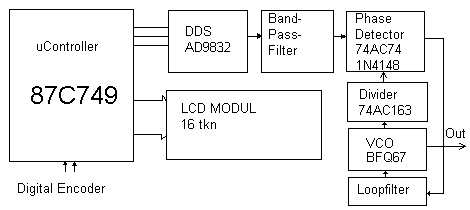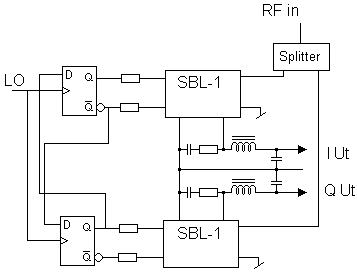I am making a "R2" DC receiver for the 40 and 80 meter HAM bands. It is possible to make it work on the other short wave HAM bands but for the moment I chose 40 and 80 meter because of the Swedish QRP contest. I also intend to make a QRP transmitter so it will be a transceiver.
The original article of the R2 Receiver was published in the January issue of QST 1993, and it can also be found in THE ARRL HANDBOOK"
Some components as variable shaft capacitors has more or less gone out of market but many new nice components have arrived instead.
The DDS - Local oscillator
I have used a DDS circuit from Analog Devices (AD9832). It is very
small, it is housed in a 16 pin SO capsule and it contains all the necessary
parts to build a good synthesizer. It is clocked with a 25 MHz clock and
deliver frequencies from DC to about 10 MHz with a resolution of about
0.01 Hz.

The local oscillator frequency is chosen to be 56 MHz because I use a divide by four 90 degree frequency divider. To make the synthesizer to output this frequency I used a VCO and a simple PLL circuit to lock it to the DDS. To change frequency from 7.0 to 3.5 MHz I simply divide the oscillator frequency by to to 14 MHz.

Figure 1. 90 degree frequency divider and mixer
Mixer
As mixer I have chose the standard SBL-1 from Mini-Circuits. When used
in the circuit in figure 1 i have measured -95 dBm carrier leakage on 3.5
MHz. The mixers is switched with a square wave current from the 74AC74
circuits.
The antenna signal passes a band pass filter and a power splitter before it retch the mixers.
Diplexer
The Preamplifier
Phase shifters
Low pass filter
To begin with I used the same circuit as in the handbook for the loupes
filter. I plane to use an active filter with turn able cutoff frequency.
This will give me a sort of pass band turning.
AGC
LCD and controller
To show the frequency I am using a LCD module (1x16 char). It works
well.
To control the frequency I am using a two channel digital shaft encoder.
They are relative expensive so one way to make an inexpensive one is to
modify an "old" computer mouse.
I use an 80C752 micro controller to decode the shaft encoder, display
the frequency and update the DDS circuit to right frequency. It works well.
The reason I chose the 80C752 is because I found it in my junk box.
The controller have built in A/D converter so I can easy read output power
and other analog signals and display it on the LCD. I will change
micro controller to 87C749 because the 87C752 have a I2C buss that I don't
need.
To adjust the frequency for TX/RX offset I simply ground a pin on the
controller and the program updates the DDS to a suitable frequency offset.
The Transmitter
Goal:
- 4 Watt output
- Side tone oscillator form the PWM pin of the 87C549
- RIT
- QSK
- SWR and Power reading on the LCD
Related links:
Analog Devices: data sheet for the AD9832, AD797.
N E w 2000 01 20
Demo software.
Check it out, it have a 2.5 kHz SSB filter.
connest the two channels from the R2 receiver
to left and right of your soundcard (Line input)
This is a very simple demo. I have only tested it on my computer.
Download it and put it in a directory
together with the bitmap file. It runs directly
without any installations.
I have made some experiments with the R2 receiver
connected to the PC sound card.
By connecting the output from the first amplifiers
after the mixers to right and left input of the souindcard (AUX.) it is
possible to make really good receiver with real time spectrum display.
The software consist of a 1024 points complex FFT and then a mask for the desired frequencies, then a IFFT.
If you listen to this it will sound bad, the FFT
need a window function.
With a window like Hamming it works better but
you have to update only half the 1024 samples every time and add ti together
at the end.
The window have to be symmetrical in the way
that the sum of the last 512 samples and the new 512 samples will give
a constant value.
I will explain this better later or put a working
program on the web.
The filter is very easy to change and it is sharp
with minimum ringing.
The Spectrum is so fast that a slow CW signal
is readable on the screen.
Any interest or comments are welcome.
The receiver is not fully made yet but I have listen to it and it sounds
great!
If you think that this is interesting or if you have any questions
pleas send me a e-mail.